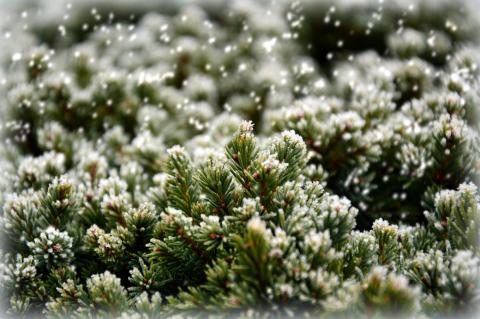December Gardening Tips

Tips for New Hampshire gardeners in December
Clean, sharpen, and store garden tools. Well-maintained tools with sharp, clean blades can potentially last for decades.
Start by removing dirt and grime with warm, soapy water and a scrubby sponge. Wipe them dry and then remove rust by using WD-40, a wire brush, or sandpaper. To sharpen, file edges in one direction at a 20 to 45 degree angle, trying to follow the original bevel. For items that require a finer edge, like pruners or loppers, use a whetstone to finish. Before storage, wipe wooden handles with linseed oil, and apply a thin coat of mineral oil to metal parts to prevent rusting.
Purchasing local foods needn’t be restricted to the summer and fall.
A number of winter farmers markets are offered throughout New Hampshire, where you can expect to find vegetables, fruits, maple, meat, dairy, baked goods, prepared foods and crafts. Most market locations require masks and social distancing protocols to keep shoppers and vendors safe from COVID-19.
Check on stored produce and tender bulbs often, and remove anything that is showing signs of decay.
One rotten bulb, tuber or root can quickly spoil the entire bunch. Ideally, carrots, potatoes, onions, and tender flower bulbs should be kept chilled (below 50℉ but above freezing), in a dark, humid place, such as a root cellar. Under ideal conditions it is possible to keep them fresh and healthy for months. If you don’t have a good way of keeping produce cool, use it as quickly as you can, and be especially vigilant on checking for spoilage.
Make sure to protect new indoor plants when bringing them home.
Rapid and severe temperature fluctuations can damage leaves and flowers, if not kill plants. Even brief exposure to freezing cold temperatures can cause injury. Ideally, you should wait to bring home new tropical plants until the temperature is above freezing. If that isn’t an option, the next best thing you can do is cover them with a plastic sleeve or bag to trap some warmer air around them until you can get the plants into a warm car, and then your home. Depending on the plant you have purchased, damage can potentially occur below 50℉, so don’t leave plants in the car while you run other errands. Poinsettias are especially cold sensitive, and will lose colorful bracts and leaves if they are exposed to winter temperatures for too long.
Keep poinsettias and other gift plants away from drafts, appliances, and heating registers.
Dry air from these sources can cause rapid water loss from the foliage and flowers, and significantly reduce the length of time plants look healthy. If plant roots can’t absorb enough water to make up for what lose, they will wilt and the flowers are buds are likely to drop prematurely. Additionally, make sure flowering plants are located in a spot where they will receive bright, indirect light for most of the day, near a south or southwest-facing window. Proper watering is also important for keeping plants healthy. Let the soil dry out between watering, and punch holes in the bottom of decorative foil wraps to allow excess water to drain freely. Shallow saucers can be placed beneath pots to collect drainage water, then emptied to prevent disease and insect problems.
Wait to plant evergreen trees and shrubs until the spring.
Evergreens are prone to winter damage if they don’t have time for their roots to become established before the ground freezes. Because they do not shed their leaves, evergreens lose water over the winter in a process called transpiration. Water loss is greatest during periods of strong winds and mild sunny weather. During periods of super cold weather the ground freezes and cuts off water to the plant’s roots. Under these conditions water is transpired faster than it is taken up, and the leaves can begin to dry out and turn brown. Evergreens that have had their root systems disrupted from planting are even more vulnerable to damage.
Decide which fruit trees you would like to order for the 2021 growing season.
Many commercial nurseries begin accepting orders in December and January. Ordering early is important if there are specific varieties that you want to get, as popular ones often sell out early. When selecting your trees, pay close attention to the descriptions of the rootstock that they are grafted onto. Rootstock is important for controlling tree size, drought tolerance, years to fruiting, anchorage, and pest and disease resistance. Dwarf and semi-dwarf root stocks are usually a good choice for home gardeners because they bear fruit at a younger age and are easier to spray and prune. Pest resistance and cold hardiness are two other traits to consider, especially for gardeners who don’t want to spray pesticides. Choosing low-input tree fruit varieties is a good way to grow healthy productive trees with limited pest control.
Do you love learning about stuff like this?
SUBSCRIBE TO GRANITE STATE GARDENING
A monthly newsletter for New Hampshire gardeners, homesteaders and plant-lovers of all kinds, that includes seasonal suggested gardening tips, upcoming events and articles with proven solutions for your garden and landscape.
Got questions? The Ask UNH Extension Infoline offers practical help finding answers for your home, yard, and garden questions. Call toll free at 1-877-398-4769, Monday to Friday, 9 a.m. to 2 p.m., or e-mail us at answers@unh.edu.
